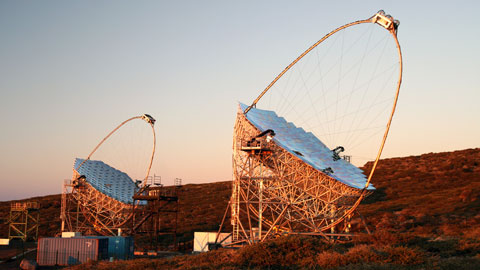Registry of unusual black hole gamma ray flares

07/11/2014
On the night of 12 to 13 November 2012, the MAGIC gamma ray telescopes at the Observatorio del Roque de los Muchachos (La Palma, Canary Islands) was observing a Perseus cluster of galaxies - located at a distance of some 260 million light-years - when scientists detected an unusual phenomenon coming from one of the clusters, known as IC310. As with many other galaxies, IC310 contains in its centre a super-massive black hole (several billions of times larger in mass than the sun) which sporadically produces gamma ray flashes. What surprised scientists on this occasion was the extreme brevity of these flares, which lasted only a few minutes.
"Relativity tells us that no object can emit for a time shorter than it takes light to cross it. We know that the black hole in IC310 has a size of about 20 light-minutes, approximately three times the distance between the Earth and the Sun. This means that the black hole cannot produce a flare shorter than 20 minutes", explains Julian Sitarek, a Juan de la Cierva researcher at the Institute for High Energy Physics (IFAE) in Barcelona, and one of the three leading scientists of this work. Nonetheless, the flares which had been observed emitting from IC310 lasted less than five minutes.
Scientists of the MAGIC collaboration propose a new mechanism, according to which this "gamma ray storm" is produced in the vacuum regions formed near the magnetic poles of the black hole. In these vacuum regions very intense momentary electrical fields are created and destroyed when the area is once again occupied by charged particles. These particles accelerate at near-light speed, subsequently transferring part of their energy to the photons they find in their way, thus converting them into gamma rays. The time needed for the light to cross one of these vacuum regions is of a few minutes, which coincides with the phenomenon observed in the IC310's black hole. "It is similar to what happens in an electric storm", explains Oscar Blanch, Ramón i Cajal researcher at the IFAE and co-director of the MAGIC Collaboration. "A power difference is created that is so strong that it ends up discharging into lightning." In this case, the discharge can achieve energy levels much higher than those observed in nature, and produce gamma rays. The black hole seems to be enveloped in a storm of colossal dimensions.
Until now, gamma ray emissions from galaxies such as IC310 are thought to have generated in the particle jets produced by the black hole. These jets are detected in many galaxies, and stretch out over billions of light years. When one of the jets points directly towards the Earth, a relativist effect known as "apparent superluminous motion" occurs, since the emitter (jet particles) and emission (gamma rays) travel towards the Earth at similar speeds. As a result, the intensity of gamma ray emissions measured is larger, and its variability quicker. But this explication is not valid in the case of IC310, because its jets do not point towards the Earth. Most probably the gamma rays come from much further within: practically from the black hole itself.
MAGIC is the present of a young yet fruitful field of science known as Ground-based Gamma-ray Astronomy. Its successful presence at the Observatorio del Roque de los Muchachos of the Instituto de Astrofísica de Canarias dates back to the 1980s, with the HEGRA telescopes. The immediate future of this field is represented by the Cherenkov Telescope Array (CTA), which is formed by some 100 telescopes distributed in two observatories (in the Northern and Southern hemispheres). The Spanish groups at MAGIC have presented their candidature for the construction of the CTA-North Observatory on Roque de los Muchachos or on Teide. This possibility represents one of the best opportunities for Spain to become home to one of the largest scientific facilities in the world which will mark the progress of astronomy in the years to come.
MAGIC consists of two, 17-m diameter reflective telescopes, built and operated by an international collaboration of 160 scientists from Spain, Germany, Italy, Poland, Switzerland, Finland, Bulgaria, Croatia, Japan and India. This year it celebrates its tenth anniversary with the publication of its fifth scientific paper in the journal Science. Spain's greatest contributions to the building of the MAGIC Collaboration has been the original camera of one of the telescopes, a large part of the electronics and the data centre. The quality of the air of the island of La Palma has contributed decisively to its success. Spanish institutions participating in the collaboration include the Institute of High Energy Physics (IFAE, Barcelona), the Universitat Autònoma de Barcelona, the University of Barcelona, the Institute of Space Sciences (CSIC, Barcelona), the Institute of Astrophysics of the Canary Islands (IAC, La Llacuna), the Complutense University of Madrid and the Centre for Research in Energy, Environment and Technology (CIEMAT, Madrid).